Push vs. Pull Marketing: Key Distinctions

Decoding Push vs. Pull Marketing in the Digital Era: Insights from a Digital Marketer
Navigating the digital marketing landscape requires a strategic choice between two core principles: push and pull marketing. As a digital marketer, I understand the importance of balancing your budget, time, and resources between organic and paid strategies to achieve the best results for your business.
Choosing Between Push and Pull Marketing
Understanding the difference between push and pull marketing is vital for your strategy. Push marketing involves actively promoting your brand to target audiences, often through paid advertising or promotions. Pull marketing, on the other hand, attracts consumers naturally to your brand or products, usually through engaging content.
Both strategies encompass a variety of techniques, including search engine optimization (SEO), content marketing, and social media advertising. Knowing which approach suits your needs depends on your business’s short-term and long-term goals.
Push Marketing: The Aggressive Approach
Push marketing is proactive, aiming to generate immediate sales. This strategy is ideal when:
- Launching a new business or product.
- Targeting seasonal promotions.
- Entering new markets.
- Needing quick cash flow.
- Clearing inventory.
- Boosting brand awareness in competitive markets.
Push marketing often requires a financial investment. Popular methods include pay-per-click (PPC) advertising and paid social media marketing, where you pay for banners, ads, and shopping ads on various platforms.
Pull Marketing: The Organic Growth Strategy
Pull marketing relies on organic traffic. It involves creating valuable content to attract your target audience. This strategy is most effective for:
- Long-term sustainable growth.
- Building a loyal customer base.
- Enhancing brand awareness through engagement.
- Increasing organic website traffic.
- Interacting with customers early in their buying journey.
Key methods include SEO, creative social media content, and leveraging customer reviews. While SEO has long been a powerful marketing tool, social media is a more recent, lucrative addition to pull marketing strategies.
Balancing Both Strategies for Optimal Success
A recent study revealed that 71% of consumers prefer pull marketing methods. Content marketing, search engine contributions to website traffic, and social media’s growing user base highlight the importance of pull strategies for future business growth.
However, push strategies, like paid search ads, remain influential. For instance, paid-search ads in the retail sector account for a significant portion of revenue.
For the best results, businesses should use a multi-channel approach, leveraging both push and pull strategies.
Key Techniques in Push and Pull Marketing
- SEO and Content Marketing: SEO is a long-term strategy with a high ROI. It requires optimizing your website for search engines to attract more organic traffic. Meanwhile, content marketing blurs the lines between push and pull, providing valuable content to engage your audience.
- Social Media Marketing: Social media offers avenues for both push (paid ads) and pull (organic content) strategies. Engaging content
on social media platforms can organically attract and retain customers, while paid social media advertising targets specific audiences to enhance reach and sales.
- Search Engine and Display Network Advertising: This push strategy involves paying for prominent placement in search results or on display networks. It’s a direct approach to reach potential customers, often yielding quick results.
In conclusion, the choice between push and pull marketing strategies is not a binary one. Successful digital marketing often involves a blend of both, tailored to your business goals and the evolving digital landscape. Understanding your audience’s preferences, leveraging the strengths of each approach, and maintaining a flexible strategy can lead to sustainable growth and a strong online presence for your business.